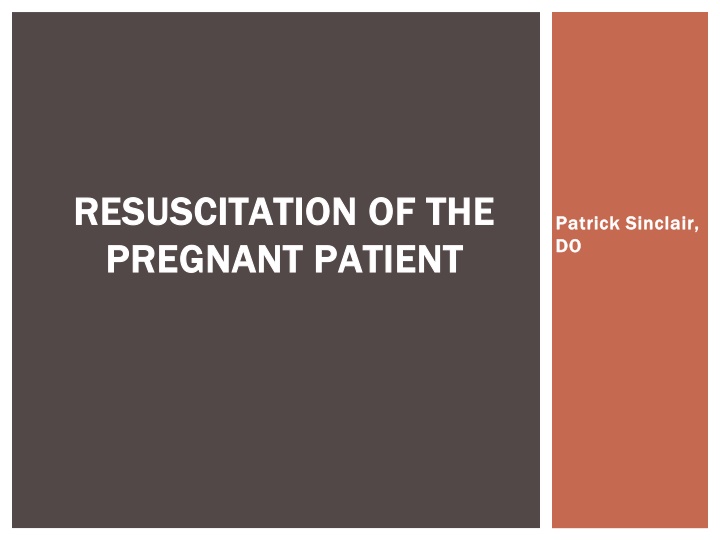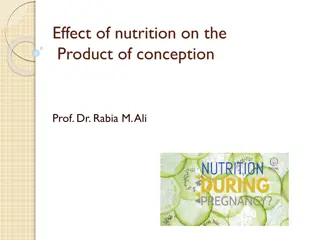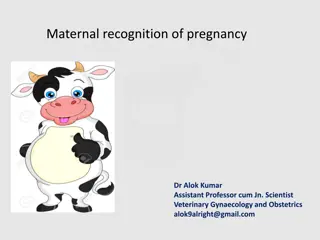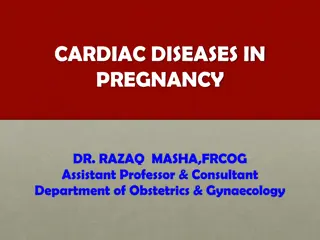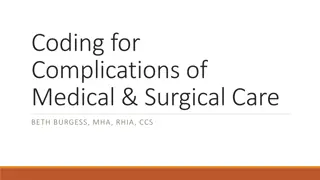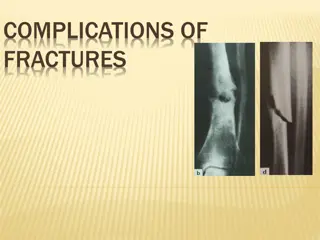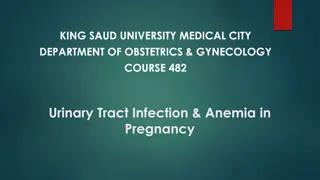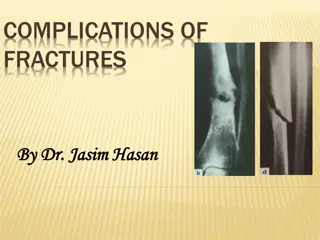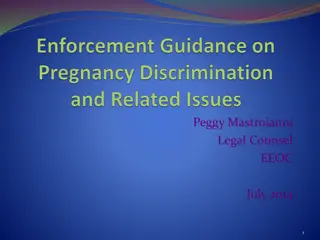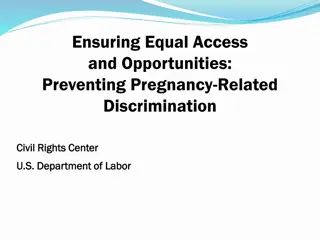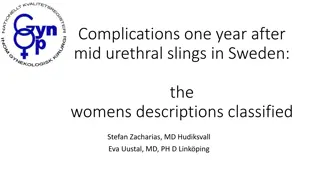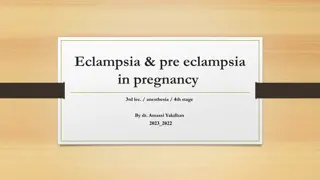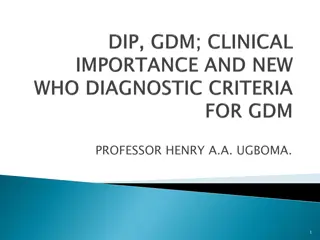Managing Pregnancy-Related Complications: A Comprehensive Overview
Understand the risks and causes of pregnancy-related complications such as resuscitation, DIC, peripartum cardiomyopathy, and more. Learn about management strategies including resuscitation protocols, DIC treatment, and heart failure management. Dive into the prevalence, causes, and treatment of these critical conditions affecting pregnant patients.
Download Presentation

Please find below an Image/Link to download the presentation.
The content on the website is provided AS IS for your information and personal use only. It may not be sold, licensed, or shared on other websites without obtaining consent from the author.If you encounter any issues during the download, it is possible that the publisher has removed the file from their server.
You are allowed to download the files provided on this website for personal or commercial use, subject to the condition that they are used lawfully. All files are the property of their respective owners.
The content on the website is provided AS IS for your information and personal use only. It may not be sold, licensed, or shared on other websites without obtaining consent from the author.
E N D
Presentation Transcript
RESUSCITATION OF THE RESUSCITATION OF THE PREGNANT PATIENT PREGNANT PATIENT Patrick Sinclair, Patrick Sinclair, DO DO
RISK BY THE NUMBERS RISK BY THE NUMBERS Prevelance: 1/20,000 to 1/50,000 ongoing pregnancies Prevelance: 1/20,000 to 1/50,000 ongoing pregnancies - Complicates 1/12,000 US hospitalizations related to delivery Complicates 1/12,000 US hospitalizations related to delivery - Its frequency has remained stable over the past 15yrs. Its frequency has remained stable over the past 15yrs.
CAUSES CAUSES The BEAU The BEAU- -CHOPS mnemonic: CHOPS mnemonic: Bleeding/DIC (17%) Bleeding/DIC (17%) Embolism (29%) Embolism (29%) Anesthesia (2%) Anesthesia (2%) Uterine Atony Uterine Atony Cardiac Disease (peripartum cardiomyopathy) (8%) Cardiac Disease (peripartum cardiomyopathy) (8%) Hypertensive Disease (2.8%) Hypertensive Disease (2.8%) Other Other Placenta (abruption/previa) Placenta (abruption/previa) Sepsis (13%) Sepsis (13%)
DIC DIC - - - - Increased PT, PTT, and thrombin times Increased PT, PTT, and thrombin times Thrombocytopenia Thrombocytopenia Elevated fibrin degradation products Elevated fibrin degradation products Low fibrinogen concentration (least sensitive Low fibrinogen concentration (least sensitive and late finding) and late finding) Treatment: Treatment: Massive transfusion protocol Massive transfusion protocol - - usually RBCs, FFP, and platelets in a usually RBCs, FFP, and platelets in a 1:1:1 ratio 1:1:1 ratio Causes: Causes: Massive hemorrhage, placental abruption, HELLP Massive hemorrhage, placental abruption, HELLP syndrome, amniotic fluid embolus, acute fatty syndrome, amniotic fluid embolus, acute fatty liver of pregnancy, septic abortion liver of pregnancy, septic abortion
PERIPARTUM CARDIOMYOPATHY PERIPARTUM CARDIOMYOPATHY Development of heart failure in the last month of pregnancy or Development of heart failure in the last month of pregnancy or within five months of delivery within five months of delivery Clinical symptoms consistent with heart failure Clinical symptoms consistent with heart failure Prognosis is variable (complete recovery, partial recovery, no Prognosis is variable (complete recovery, partial recovery, no recovery) and there is significant risk in subsequent pregnancies recovery) and there is significant risk in subsequent pregnancies Management follows standard heart failure tx guidelines Management follows standard heart failure tx guidelines (ARBs and ACEs contraindicated in pregnancy (ARBs and ACEs contraindicated in pregnancy - ->hydralazine) A clear pathophysiology is unknown (inflammatory and A clear pathophysiology is unknown (inflammatory and immunological theories vs. hemodynamic vs. prolactin vs. genetic) immunological theories vs. hemodynamic vs. prolactin vs. genetic) Risk Factors: age>30, multiparity, African descent, multiple Risk Factors: age>30, multiparity, African descent, multiple fetuses, hx of pre fetuses, hx of pre- -E, E, postpartum HTN, cocaine, long E, E, postpartum HTN, cocaine, long- -term oral tocolytic therapy w/ terbutaline (beta agonists) tocolytic therapy w/ terbutaline (beta agonists) >hydralazine) term oral
AMNIOTIC FLUID EMBOLUS AMNIOTIC FLUID EMBOLUS Amniotic fluid enters maternal circulation through endocervical Amniotic fluid enters maternal circulation through endocervical veins, the placental insertion site, or uterine trauma veins, the placental insertion site, or uterine trauma Rare: 1 to 12 per 100,000 deliveries Rare: 1 to 12 per 100,000 deliveries Most commonly occurs during delivery or postpartum Most commonly occurs during delivery or postpartum Can cause 1) cardiogenic shock 2) respiratory failure 3) Can cause 1) cardiogenic shock 2) respiratory failure 3) anaphylactoid response anaphylactoid response Unpredictable, unpreventable and a clinical diagnosis Unpredictable, unpreventable and a clinical diagnosis Tx: O2, vasopressors and IVF Tx: O2, vasopressors and IVF (hemodynamic support) (hemodynamic support) Maternal Mortality: ~20% Fetal Mortality: 20 Maternal Mortality: ~20% Fetal Mortality: 20- -60% (50% w/ neurologic sequelae) neurologic sequelae) 60% (50% w/
TOXICOLOGY TOXICOLOGY Magnesium Magnesium Calcium gluconate Calcium gluconate Bupivicaine induced arrythmia Bupivicaine induced arrythmia Amiodarone Amiodarone Bupivicaine Toxicity Bupivicaine Toxicity lipid emulsion (20%) lipid emulsion (20%) Hyperkalemia Hyperkalemia Sodium Bicarbonate Sodium Bicarbonate
AND NOW BACK TO RESUSCITATION AND NOW BACK TO RESUSCITATION First, a few points: First, a few points: Normal pregnancy is associated with Normal pregnancy is associated with a mild respiratory alkalosis a mild respiratory alkalosis Decreased functional residual capacity Decreased functional residual capacity Increased O2 consumption Increased O2 consumption Increased pulmonary shunting Increased pulmonary shunting It all comes down to the ABCs It all comes down to the ABCs
AIRWAY AND BREATHING AIRWAY AND BREATHING Changes in the maternal airway can make intubation difficult Changes in the maternal airway can make intubation difficult (edema, increased secretions) (edema, increased secretions) Use ET tube that is .5mm Use ET tube that is .5mm- -1.0mm smaller in internal diameter 1.0mm smaller in internal diameter than what would be used for a non than what would be used for a non- -pregnant patient pregnant patient Elevated diaphragm may result in the need for decreased Elevated diaphragm may result in the need for decreased ventilation volumes and increased resistance to ventilation ventilation volumes and increased resistance to ventilation Hyperventilation can be particularly serious as the resulting Hyperventilation can be particularly serious as the resulting respiratory alkalosis can be more severe resulting in uterine respiratory alkalosis can be more severe resulting in uterine vasoconstriction and fetal hypoxia (acidosis) vasoconstriction and fetal hypoxia (acidosis)
CARDIOVASCULAR SUPPORT CARDIOVASCULAR SUPPORT Chest compressions should be targeted above the center of the Chest compressions should be targeted above the center of the sternum sternum IV access: bilateral 14 gauge antecubitals or IO access, or central IV access: bilateral 14 gauge antecubitals or IO access, or central lines lines When defibrillating, make sure all FHM and TOCO devices are When defibrillating, make sure all FHM and TOCO devices are disconnected from that patient to avoid electrocution (thus FHM is disconnected from that patient to avoid electrocution (thus FHM is contraindicated in resuscitation of the pregnant patient) contraindicated in resuscitation of the pregnant patient) Avoid aortocaval compression! Avoid aortocaval compression!
AORTOCAVAL COMPRESSION AORTOCAVAL COMPRESSION - Critical for perfusion and venous return! Critical for perfusion and venous return! - Studies favor the use of manual uterine displacement over table tilt (less Studies favor the use of manual uterine displacement over table tilt (less episodes of hypotension and lower ephedrine requirement) episodes of hypotension and lower ephedrine requirement) - Manual displacement also allows for the patient to remain supine allowing for Manual displacement also allows for the patient to remain supine allowing for maximum resuscitative force during chest compressions maximum resuscitative force during chest compressions - If a tilt is used, optimal angle=27, which allows for 80% of maximal force If a tilt is used, optimal angle=27, which allows for 80% of maximal force
THE DECISION TO DELIVER THE DECISION TO DELIVER The The 4 4- -Minute Rule states that C Minute Rule states that C- -section should be initiated if ROSC has not occurred within ROSC has not occurred within 4 4 minutes of maternal cardiorespiratory collapse and delivery of the newborn should cardiorespiratory collapse and delivery of the newborn should occur within 5 minutes occur within 5 minutes section should be initiated if minutes of maternal This also requires a minimum gestational age of 2 This also requires a minimum gestational age of 24 4 weeks; necessitating that estimation of gestational age be part of the necessitating that estimation of gestational age be part of the ABC assessment of the pregnant patient ABC assessment of the pregnant patient weeks; 2 24 4 wga = wga = 4 4 finger breadths above the umbilicus finger breadths above the umbilicus
DELIVERY AS A TX DELIVERY AS A TX Studies have reported a return of maternal circulation in as many Studies have reported a return of maternal circulation in as many as 60% of cases as 60% of cases Relieving aortocaval compression results in a 60 Relieving aortocaval compression results in a 60- -80% increase in CO CO 80% increase in Delivery within 5 minutes of collapse remains extremely elusive Delivery within 5 minutes of collapse remains extremely elusive Mortality: Maternal = 40% Mortality: Maternal = 40%- -83%, Neonate = 11% 83%, Neonate = 11%- -58% 58%
REFERENCES REFERENCES Uptodate.com Uptodate.com Resuscitation in Pregnancy Resuscitation in Pregnancy Kundra P, et al Manual displacement of the uterus during Caesarean section. Anaesthesia 2007; Kundra P, et al Manual displacement of the uterus during Caesarean section. Anaesthesia 2007; 62:460 62:460 Rees GA, Willis BA. Resuscitation in late pregnancy. Anaesthesia 1988; 43:347 Rees GA, Willis BA. Resuscitation in late pregnancy. Anaesthesia 1988; 43:347 Uptodate.com Uptodate.com DIC During Pregnancy DIC During Pregnancy Uptodate.com Uptodate.com Amniotic Fluid Embolism Syndrome Amniotic Fluid Embolism Syndrome
